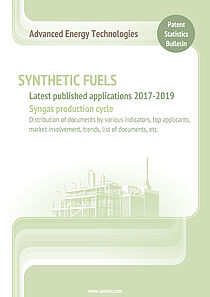SYNTHETIC FUELS. Latest published applications 2017-2019. Syngas production cycle

Summary
Syngas is one of the key resources for the production of synthetic fuels. Hydrogen, which is a part of syngas is widely used in oil refining and ammonia production. One of the main advantages of syngas is that it can be produced from almost any hydrocarbon or organic material, including natural gas, oil, coal, biomass and even municipal waste. The feedstock is exposed to a high temperature and controlled composition of the gas mixture inside the reactor, which leads to the breakdown of the complex organic molecules into a mixture of elemental hydrogen and carbon monoxide. With the subsequent application of the Fischer-Tropsch process, high quality synthetic fuels are obtained. Each stage of the production, purification and use of synthesis gas requires careful consideration to issues of efficiency, safety and high cost of the production process, as well as product quality. Companies such as Mitsubishi Hitachi Power Systems Ltd, Haldor Topsoe A / S and Air Liquide take an active part in the development of this technology.
The present bulletin reviews patent applications granted by patent offices around the globe in 2017-2019 in the field related to syngas production cycle. General research methodology can be found on the Advanced Energy Technologies website. 2134 patent documents from 37 patent offices around the world are represented in the bulletin. In total, 718 applicants from 37 countries and 1040 subgroups of the International Patent Classification are mentioned.
Key Highlights
The bulletin contains statistical data on the distribution of patent documents by years, by patent offices and by applicant countries, applicant-related data (residents and non-residents), data on the most frequently mentioned International Patent Classification divisions (sections, classes, subclasses, groups, and subgroups). The top three patent offices that granted the largest number of patent applications were CNIPA (CN), USPTO (US) and WIPO.
For each of the patent documents selected for the examination in the present bulletin the characteristics of unified indicators were preliminary defined, they include: technical problems, types of inventive solutions employed, belonging to one or other technological segment. This allows the internal content for each of the indicators in the aggregate array of documents to be visualized, for instance, to define the sequence and proportional correlation of technical problems the inventive solutions disclosed in the texts aim to solve. A list of the top 10 groups consisting of patent documents with identical unified indicators contains ID numbers and applicant names of respective documents; the groups are sorted by the number of patent documents.
A list of the top 10 applicants by the number of patent documents includes Mitsubishi Hitachi Power Systems Ltd (JP), Haldor Topsoe A/S (DK), Air Liquide (FR), China Petroleum & Chemical Company (CN), L'air Liquide, Société Anonyme Pour L'etude Et L'exploitation Des Procédés Georges Claude (FR), Linde AG (DE), Huaneng Clean Energy Research Institute (CN), Sinopec SRIPT Shanghai Research Institute of Petrochemical Technology (CN), ENN Science & Technology Development Co Ltd (CN), Shell Internationale Research Maatschappij B.V. (NL).
Data representing the share in the established intellectual property market, distribution of documents by problems, IPC sections, patent offices is provided in the form of tables and diagrams for them.
The prominent documents pages contain the top 10 patent applications with the highest bibliographical rating, the most extensive coverage of IPC sections, and top prominent single applications.
The conclusive part of the bulletin represents the lists of all of the documents reviewed, arranged by the top 10 groups of patent documents with identical unified indicators and by patent offices with the indication of the ID numbers of the granted patents.
Who needs this bulletin?
The proposed patent statistics bulletin allows the existing trends in the intellectual property market of the specified industrial sector to be timely traced, as well as the possibility of acquiring a carefully selected list of patent documents fully corresponding to the specified subject. The bulletin can be useful for inventors, engineers, scientific workers, and business representatives, who are focused on the development of syngas production.


